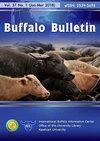提高埃及水牛产奶量和持久性的特征向量选择指标
IF 0.2
4区 农林科学
Q4 AGRICULTURE, DAIRY & ANIMAL SCIENCE
引用次数: 0
摘要
根据随机回归模型,使用特征向量指数估计了牛奶产量和持久性的遗传增益,并将其与传统的选择指数进行了比较。该数据集包含691头水牛、120头父系和532头母系的女儿记录的4971个试验日产奶量。该模型包括直接加性遗传、永久环境和误差的随机影响,而固定影响是群体试验日、产仔和产次的年份和季节,作为协变量,是产奶日。第一和第二特征值分别解释了73.1%和22.9%的随机回归系数的变化,表明使用前两个特征向量是足够的。基于第一特征向量指数(Ie1)和基于常规选择(IMY)的总产奶量(TMY)的遗传反应在每个指数中都有大约171kg的接近增益。第二特征向量指数(Ie2)显示TMY增加(9.91kg),因此持续性增加(0.86kg)。TMY和持久性是乳制品生产中两个经济上重要的性状,利用第二特征向量指数(I*2)可以获得TMY在持久性方面的额外遗传增益和高遗传增益。本文章由计算机程序翻译,如有差异,请以英文原文为准。
Eigenvector selection indices for improving milk yield and persistency in Egyptian buffalo
The genetic gains were estimated for milk production and persistency, derived from random regression models, using eigenvector indices, and they were compared with the traditional selection index. The data set contained 4971 test day milk yield recorded for 691 buffalo cows, daughters of 120 sires and 532 dams. The model included the random effects of direct additive genetic, permanent environment and error, whereas the fixed effects were herd test day, year and season of calving and parity, and as a covariate, it was milk days. The first and the 2nd eigenvalues explained 73.1 and 22.9% of the variation of the random regression coefficients, respectively, suggesting that the use of the first two eigenvectors is sufficient. Genetic responses in total milk yield (TMY) based on the first eigenvector index (Ie1) and that based on the conventional selection (IMY) have close gain of about 171 kg in each index. The second eigenvector index (Ie2) showed an increase in TMY (9.91 kg), and thus an increase in the persistency (0.86 kg). The TMY and persistency are the two economically important traits in dairy production, additional genetic gains in persistency and high genetic gain for TMY could be obtained using the 2nd eigenvector index (I*2).
求助全文
通过发布文献求助,成功后即可免费获取论文全文。
去求助
来源期刊

Buffalo Bulletin
AGRICULTURE, DAIRY & ANIMAL SCIENCE-
CiteScore
0.50
自引率
0.00%
发文量
53
审稿时长
>12 weeks
期刊介绍:
Buffalo Bulletin is published quarterly in January-March, April-June, July-September and October-December. Contributions on any aspect of research or development, progress reports of projects and news on buffalo will be considered for publication in the bulletin.
 求助内容:
求助内容: 应助结果提醒方式:
应助结果提醒方式:


